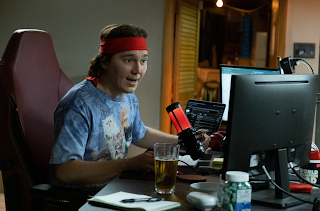 |
| Ryunosuke Kamiki in "Godzilla: Minus One" Photo Credit: RottenTomatoes.com |
With over 30 films in the “Godzilla” franchise, dating all the way back to the ‘50s, it’s safe to say that this sea creature born from the aftermath of nuclear warfare is cinema’s most enduring movie monster. Aside from the main series of films from Japan, there’s Roland Emmerich’s much-maligned 1998 interpretation, and the flawed, yet entertaining iteration from Gareth Edwards in 2014. Although I never followed the series as a whole, I did enjoy the original 1954 film from Ishirō Honda. Other than that one, I’ve only seen the two films from Emmerich and Edwards.
We now have a new Godzilla film in the main franchise with writer-director Takashi Yamazaki’s “Godzilla: Minus One.” While this is the 33rd film in the main series, it nevertheless proves that, no matter how long a set of films has been running, you can always deliver something huge, so long as you have an engaging story to tell.
In 1946, kamikaze pilot Kōichi Shikishima (Ryunosuke Kamiki) returns home from war, guilt-ridden over abandoning his duties after many others had perished. Slowly, he begins to rebuild his life with Noriko Ōishi (Minami Hamabe), who has taken in an abandoned infant. Soon, Kōichi and Noriko establish a stable life, and the former finds work as a minesweeper out in the ocean. When Godzilla reawakens and starts wreaking havoc on Tokyo, Kōichi and his seafaring crew must band together with others in order to defeat it.
Kamiki gives an astonishing performance of a man who’s haunted by his actions during the war. This is the type of emotional, fathoms-deep acting that’s all too rare in blockbuster-sized films these days and is a role that will hopefully introduce as many western audiences as possible to his talent. Throughout this film, Kamiki exhibits the levels of despondency that he feels at having people look at him as a coward. Between this and the anguish that he feels over the people in his life that he has lost, Kamiki lets us know that this isn’t going to be a soulless special-effects movie, but one whose performances feel as big as the set-pieces. We see the intense internal conflict play out in him as he tries to readjust to a society that thinks little of him, all while he attempts to find a way to prove himself when his life and those around him get thrown in the path of danger once again.
All of the supporting characters have impactful chemistry with the lead that results in superb dramatic moments between them. Just like Kōichi, these other characters feel like real people, all of whom share the same shattering hardships of having to face a threat after just emerging from a previous one. With Hamabe as Kōichi’s partner, Yuko Yamada, Hidetaka Yoshioka, and Kuranosuke Sasaki as Kōichi’s boat crew, Munetaka Aoki as a former Navy Air Service technician, and Sakura Ando as Kōichi’s kind neighbor, each of them is engaging in their own way, and they all offer so much more than what you’d expect upon first meeting them.
The screenplay by Yamazaki doesn’t allow for the big special-effects set pieces to get in the way of an absorbing human story. After a heart-pounding opening sequence, we gain further access into Kōichi’s life and those of the people around him. We have detailed look into how the war has impacted the characters and the ways in which they try to rebuild provides the story with a depth that has you form tight bonds with Kōichi and the others. Between the stretches of the narrative that concern the human characters, we have Godzilla scenes that absolutely deliver. These sequences are lengthy enough to help us appreciate the sci-fi scope of the film, but never go on for too long in a way that sidelines the drama.
Just as what was accomplished in Honda’s original film, Yamazaki’s script brings an anti-war story that’s beautifully told through its characters, providing a sweep of emotions that a big special-effects narrative like this deserves. With this approach to the story, Yamazaki gives us a movie that’s every bit as character driven as it is special-effects driven.
As a director, Yamazaki maintains a serious tone throughout the film, never feeling the urge to inject jokes for the sake of it. He meditates on the sense of loss and uncertainty that these characters feel, allowing us to meditate on how they’re processing what’s happened to them both before the events of the movie and what happens in the present.
As far as the sequences with Godzilla go, Yamazaki stages epic monster scenes that let this famous creature continue to flourish with the help of modern visual effects. Pairing with cinematography by Kōzō Shibasaki, who has provided the camerawork for many of Yamazaki’s films, these huge set-pieces capture all of the thrills and devastation for which these films have become known. In these scenes, Shibasaki and Yamazaki frame Godzilla in all of his terrifying glory, and you’ll be in awe whenever the titular creature fills up the screen to the point of breaking out of it.
Given how much “Godzilla: Minus One” succeeds in the scope of its characters and vastness of its visual effects, this is a film that shows how a decades-old monster still has the power to leave other blockbuster franchises in its shadow.
Grade: A













